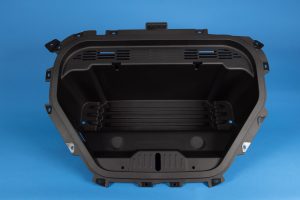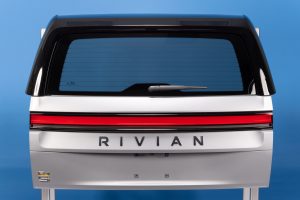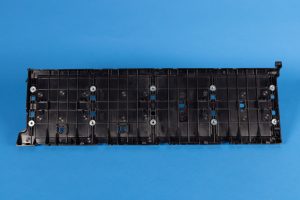When the Environmental Protection Agency announced its new emissions requirements in March, it stated that automotive manufacturers could reach those goals if electric vehicles (EVs) made up 56% of new vehicle sales in the U.S. by 2032. This is good news for composites manufacturers who are already supplying lightweight components for EVs. It also presents additional opportunities to further educate EV OEMs on how composite materials can help automakers meet their sustainability goals.
“We have a great story. I just don’t think we always do the best job telling it,” says Michael Siwajek, vice president, research and development at Teijin Automotive Technologies.
Composite materials offer many sustainability-related benefits for both EVs and internal combustion engine (ICE) vehicles. “They have a lower overall carbon footprint than metals once you account for the low carbon impact in production and for the lower impact in use because they are thinner, lighter and stronger,” says Keith Bihary, chief business development officer at Molded Fiber Glass Companies (MFG).
Compared to traditional materials like steel, composites provide a lower density, higher strength-to-weight ratio and, depending on the material, high stiffness. “That allows for lightweighting from the lower density and also offers a potential of material reduction,” says Amanda Nummy, senior polymer materials engineer at Hyundai America Technical Center. Less raw material means less weight to transport and less energy required for processing, so the vehicle’s carbon footprint is reduced.
FRP composites also provide design freedom that allows for development of creative, sustainable options for automotive parts. They enable engineers to combine different resins and reinforcement structures to achieve the desired mechanical properties while minimizing sustainability impacts. For example, Nummy used a holistic approach to redesign an existing composite bed for a pickup truck. She considered the impact of material selection, the design itself and the processing of the part to achieve weight reduction, a big factor in vehicle sustainability.
“Another point we can make regarding sustainability benefits is a reduction in waste,” Nummy adds. “With polymer composites, we see advantages in corrosion resistance and in fracture toughness compared to metals and conventional polymers. So, you have the opportunity to have a longer service life and a reduction in waste associated with repairing or replacing components as they wear out.”
Lifecycle Advantage
The recyclability of vehicle components is always part of discussions about automotive sustainability. Thermoplastic composites are already recyclable, and the composites industry is making progress toward recycling thermosets as well. But the reality is that only a small amount of metal or composite materials from automotive production and end-of-life vehicles are currently reused in vehicle manufacturing. Although the aluminum industry claims that a majority of its scrap material is recycled within 20 days, Siwajek says that most of it actually goes into non-automotive products like beverage cans.
EV manufacturers and other OEM also appear to be moving away from focusing primarily on recyclability. “The automotive industry is more and more concerned with life cycle analysis (LCA), and composites do pretty well with that,” Bihary says.
“We have an excellent story versus metallics,” says Siwajek. “Cradle to gate, we are one-third to one-half of their LCA.” During production, for example, composites manufacturers can mold a part and ship it to their automotive customer, while a metallic part has to go from a blank to stamped dies to painting, which requires more time and energy.
Composite parts also have a lot more longevity than metallics, further adding to their LCA advantage. Siwajek recalls coming across an old Ford Explorer Sport Trac pickup truck that had hundreds of thousands of miles on it. Despite its age, the FRP pickup box looked brand new.
Cooperative Efforts Required
Both EV and ICE OEMs are committed to sustainability not only because it’s the right thing to do but also because they are facing increased regulatory pressure to reduce their carbon footprint. But defining their sustainability goals, and then identifying suppliers’ roles in achieving them, has been a multi-year and sometimes inconsistent process.
“The OEMs say they are committed to sustainability – and it shows up in the presentations that they make to supplier companies – but when the RFQs come out, it’s not on their list of requirements,” says Bihary. “The engineers who actually make the choices on materials are more focused on picking materials that they are comfortable with from a performance standpoint. While they may like the idea of using parts with sustainable components, they don’t want to take a risk with an unproven material.”
Since composite materials have the potential for so many variations in part design, OEMs have to rely on suppliers’ expertise in the early material selection and design phases.
“For example, thermal and electrical conductivity properties in a composite are going to be very different than in a metal material,” says Nummy. “So having the data, the resources and the knowledge sharing to understand how these materials perform and understand how they can enable those designs is going to be a key piece of that puzzle.”
The composites industry needs to do more to educate automotive customers about the properties and sustainability benefits their materials offer. Bihary says MFG has presented many educational programs to OEMs. The company has also teamed up with others in the industry to encourage universities to incorporate information about composites into a wider range of engineering classes so more students learn about the materials and their design possibilities.
The increased availability of material cards for composites – similar to the cards that have been available for decades for metals – will also provide some reassurance to engineers who want to use these materials.
“I think the game changer in the last couple of years has been predictive tools,” says Siwajek. As automotive designers become more confident that these tools are accurate, they are less likely to build a 15% to 30% safety factor into composites parts. They can feel comfortable designing thinner and lighter parts, which will help improve sustainability.
A Cooperative Effort
Composites manufacturers will also need to think beyond materials when making their sustainability pitches to EV makers and other OEMs. The packages about sustainability requirements that Teijin Automotive Technologies has started receiving from OEMs are much more comprehensive in their scope, according to Siwajek. They address everything from waste and energy use to child labor laws and human trafficking.
“It’s really a huge undertaking, so we’ve got to look at where we fit. How are we going to keep playing in this market? What are they going to look for, and how soon?” he says.
“OEMs are going to continue to need the support of material suppliers to meet our sustainability goals and maintain compliance, especially with anticipating and providing guidance in a changing regulatory landscape,” says Nummy. “I expect that, in the near future, we will need to include new metrics such as biodiversity and location-specific impact reporting. As regulations change, all of the stakeholders and material suppliers will need to continue to be part of the conversation on how we can best meet those.”
Meeting OEMs’ sustainability goals will require the combined efforts of composite material and parts manufacturers and suppliers all along the automotive supply chain.
“Teijin is a Tier 1 supplier, so we’re on the front line with the OEMs. We are going to be the ones that have to face the sustainability requirements,” says Siwajek. “But there’s only so much that we can do with a thermoset composite like our SMC materials, because there are 13 to 20 ingredients in there. I’m going to need my supply base to come along with me and drive some of the solutions.” He acknowledges that could be difficult for small suppliers that may provide just one material.
“Everybody’s got to figure out what sustainability means to them and how it fits into the landscape moving forward,” says Siwajek.
Mary Lou Jay is a freelance writer based in Timonium, Md. Email comments to mljay@comcast.net.
Filler Enables Faster Production
A new light-curable filler and sealant technology from Applied Molecules could help make the manufacture of composite automotive parts more sustainable.
If a composite component requires rework after initial production, manufacturers typically use isocyanate-based polyurethane fillers, adhesives and sealants to make repairs and prepare the edges of composite parts for painting. These materials need to be mixed, applied and cured at high heat for at least 15 minutes before they can be sanded.
Applied Molecules has developed a UV-curable filler that slashes the time required for rework. “It’s a one-part chemistry that’s a lot safer than the two-part fillers that need to be mixed,” says Paul Snowwhite, the company’s CEO/CTO.
The material cures in less than 10 seconds under a 15-watt LED lamp and can be sanded immediately. “We’re bringing in a very fast process that saves labor, time and even floor space because you don’t have a backlog of rework parts on the shop floor.”
The UV-curable filler would be compatible with Tesla’s proposed “unboxing” manufacturing technique. Instead of the traditional method of assembling the body chassis, applying paint and then heat curing it, Tesla would apply paint films to different components before bringing them together. It’s a more sustainable means of production because it doesn’t require curing of paint, fillers, adhesives or sealants. That would save both time and energy.
Breakthrough Automotive Applications
Automakers have reaped the benefits of composite materials in several recent cutting-edge applications, such as the three highlighted here that won 2023 Automotive Innovation Awards from the Automotive Division of the Society of Plastics Engineers (SPE®). These components reduced parts and mass, both contributing to enhanced sustainability.
The Class A Composite Mega Bin/Frunk – The frunk on the 2024 Ford F-150 Lightning electric truck has 48% less mass than previous models. The conversion from a molded, painted SMC version to an injection molded metastable intermolecular composite, long fiber reinforced polypropylene (LFT-PP) also reduced the production cycle time by 37% and eliminated the need for painting and secondary routing of holes. The frunk is now fully recycled at end of life.
Photo Credit: SPE Automotive Div.
Thermoplastic Split Gate Rear Closure System – The Rivian LLC R1S features the world’s first all-thermoplastic split gate rear closure system. The tailgate, which was made from injection molded LFT-PP and thermoplastic polyolefins, has a lower mass than metal equivalents, costs less and reduces noise, vibration and harshness. The number of parts in the tail gate was reduced from nine to two.
Photo Courtesy of SPE Automotive Div.
Battery Module Side Plates – The side plates on the Chevrolet Corvette E-Ray, made with injection-molded polyarylamide, are extremely flat and have high dimensional accuracy, stiffness and strength. The use of composite materials made it possible to reduce four components to one and allowed for incorporation of many functional features that would not be possible with metals. The mass of the side plates was reduced by 37% and the cost by 55%.
Photo Courtesy of SPE Automotive Div.




